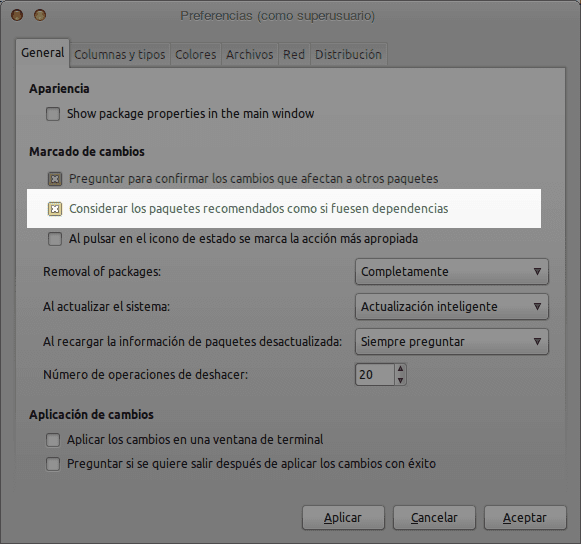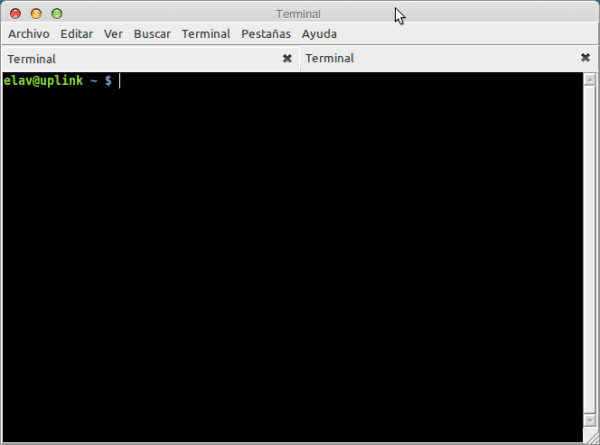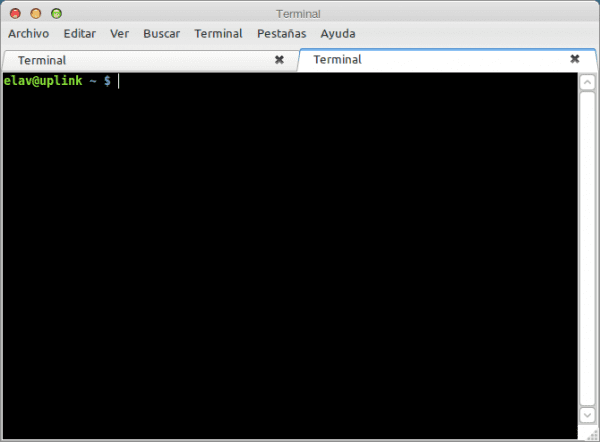In previous installments we already saw how to install y to update LMDE. Now I will show you some tips to make some small adjustments to our system.
If the update process did not present any problem and everything works correctly, we can proceed to perform certain tricks to further optimize our LMDE and make it more functional. Keep in mind that we must do this at our own risk, and if they have doubts with something they reflect it in the comments or ask who «Everything knows«.
Cheats for LMDE.
Install only what APT needs.
Generally when a package is installed, it may install the suggested and recommended dependencies for us. In many cases, one depends on the other, but not in others. With this command we will make apt only install what the package we are going to install really needs.
echo -e 'APT :: Install-Recommends "0"; \ nAPT :: Install-Suggests "0";' | sudo tee /etc/apt/apt.conf.d/99synaptic
We can also do this by Synaptic. We are going to Settings »Preferences and uncheck the option: CConsider recommended packages as dependencies.
Remove some unnecessary packages.
sudo aptitude purge live-installer-slideshow gnome-core
With this we eliminate Epiphany y Evolution. If you use both do not add gnome-core.
Customize the splash screen.
sudo cp /etc/gdm3/greeter.gconf-defaults / usr / share / gdm / greeter-config / 99_personal gksudo gedit / usr / share / gdm / greeter-config / 99_personal
Of course, for this you have to have knowledge of what you are doing
Fix timeout in GRUB.
sed -r -e 's / \ s + set timeout = \ $ \ {2 \} / set timeout = 0 / g' /etc/grub.d/00_header | sudo tee /etc/grub.d/00_header
Correct the appearance of the Terminal.
En Debian Testing some packages are being added Gnome3, and that is why some applications (such as the terminal) can look horrible. To fix this, we do the following:
sudo aptitude install gnome-theme-standard sudo cp -r / usr / share / themes / Mint-X / usr / share / themes / Mint-X2 sed -e 's / Mint-X / Mint-X2 / g' / usr /share/themes/Mint-X2/index.theme | sudo tee /usr/share/themes/Mint-X2/index.theme sudo cp -r /usr/share/themes/Adwaita/gtk-3.0/ / usr / share / themes / Mint-X2 /
Now we only have to select in Menu »Applications» Settings »Appearance theme Mint-X2. The terminal will go from this:
to this:
Now when installing this package, the GDM will display the icons adwaita and they will look something wrong. The author did not find a more viable solution than to run:
sudo rm -rf / usr / share / icons / Adwaita
Just in case make a backup
sudo cp -R / usr / share / icons / Adwaita / usr / share / icons / OldAdwaita
Turn off Bluetooth.
If you only use Bluetooth occasionally, you can use this command to disable it at startup:
sudo aptitude install rfkill sed -e '/ exit 0 / d' -e '/ rfkill block bluetooth / d' /etc/rc.local | sudo tee /etc/rc.local; echo -e "rfkill block bluetooth \ nexit 0" | sudo tee -a /etc/rc.local
Set the clock.
According to the author, setting the Hardware clock to UTC is not a good idea, especially if you use more than one operating system, so:
sed -r 's / ^ UTC = yes / UTC = no / ig' / etc / default / rcS | sudo tee / etc / default / rcS sudo apt-get install ntp
This will disable UTC time and allow synchronization with NTP servers.
Do not restart the kernel.
Now we can reboot, but we may run into a little annoying problem. If we try, it will only restart the kernel, and we will skip GRUB and so on. Already had commented about this, and I leave here the solution:
sudo apt-get remove kexec-tools
Synaptic problems.
If we have problems with Synaptic, we can fix it by installing the following packages:
sudo apt-get install apt-xapian-index sudo apt-get install apt aptitude synaptic --reinstall
This will also allow a quick search on it.
For ATI cards.
For ATI users, it is recommended to do the following:
sudo apt-get remove --purge fglrx * sudo apt-get update && sudo apt-get install fglrx-driver fglrx-control sudo apt-get install libgl1-mesa-dri-experimental compiz-fusion- * fusion-icon sudo / usr / bin / aticonfig --initial sudo reboot
The author tells us that, after restarting, we can configure the Compiz and ATI parameters, and in the latter, we must pay special attention to: Tear Free Desktop.
It also tells us, that you have discovered that you have to use Fusion-Icon (loading it at startup) to use compiz as a window manager. Execute the method "compiz-replace”He gives us Compiz only once.
For Emerald users:
sudo apt-get install build-essential libxcomposite-dev libpng12-dev libsm-dev libxrandr-dev libxdamage-dev libxinerama-dev libstartup-notification0-dev libgconf2-dev libgl1-mesa-dev libglu1-mesa-dev libmetacity-dev librsvg2-dev libdbus-1-dev libdbus-glib-1-dev libgnome-desktop-dev libgnome-window-settings-dev gitweb curl autoconf automake automake1.9 libtool intltool libxslt1-dev xsltproc libwnck-dev python-dev python-pyrex libprotobuf-dev protobuf -compiler python-sexy wget
wget http://releases.compiz.org/0.8.8/emerald-0.8.8.tar.gz tar xvzf emerald-0.8.8.tar.gz cd emerald-0.8.8 ./configure –prefix = / usr LIBS = -ldl make sudo make install
Now we just have to get some themes and test them. The author tells us that this allows the blur effect in Compiz. Using a Gaussian blur with at least a radius of 8 looks impressive.
Correct problems with typography.
You may have problems with the fonts. Sub-pixel rendering misbehaves. In order to solve it:
sudo rm /etc/fonts/conf.d/10-hinting-slight.conf sudo rm /etc/fonts/conf.d/10-no-sub-pixel.conf sudo ln -s /etc/fonts/conf.available /10-hinting-medium.conf /etc/fonts/conf.d/. sudo ln -s /etc/fonts/conf.available/10-sub-pixel-rgb.conf /etc/fonts/conf.d/. sudo dpkg-reconfigure fontconfig
Disable Speaker.
The system is almost perfect already, but it can be even better. You don't like the loud sound at startup? Or maybe the super nice sounds in the terminal? Let's disable the PC speaker!
echo "blacklist pcspkr" | sudo tee -a /etc/modprobe.d/blacklist.conf sudo rmmod pcspkr
Sound correction in Flash and Mplayer.
Speaking of sound. Have you noticed bugs in flash? Such sound distortion in Skype or Mplayer? For sound distortion, the magic recipe is as follows:
echo /usr/lib/x86_64-linux-gnu/libc/memcpy-preload.so | sudo tee /etc/ld.so.preload
This is for 32 bits. The author does not know where he can do this on 64 Bit machines.
Wake up PC with keyboard or mouse.
Would you like to wake up your PC with the keyboard or mouse? Too easy:
((echo '#! / bin / sh' && sed -rn 's /^.* (USB [0-9E] + | EUSB). * $ / echo \ 1> \ / proc \ / acpi \ / wakeup / pg '/ proc / acpi / wakeup) | sudo tee /etc/pm/sleep.d/05_usb && sudo chmod + x /etc/pm/sleep.d/05_usb)
Yes, it looks horrible, but it works right away. This trick is from the author.
Install Grub Customizer:
sudo apt-get install bzr cmake libgtkmm-2.4-dev gettext bzr branch lp: grub-customizer cd grub-customizer / cmake. && make sudo apt-get install menu hwinfo sudo make install
And apply another trick of the author:
sudo mkdir /etc/grub.d/.disabled sudo mv /etc/grub.d/06_* /etc/grub.d/.disabled/ sed -r -e 's / \ $ \ {2 \} / \ $ \ {GRUB_COLOR_NORMAL \} / g '-e' s / \ $ \ {3 \} / \ $ \ {GRUB_COLOR_HIGHLIGHT \} / g '/etc/grub.d/05_debian_theme | sudo tee /etc/grub.d/05_debian_theme> / dev / null
With this we can make it work as expected. Remember to reapply this hack every time Grub Customizer refuse to work. This will happen after updating the files /etc/grub.d/ or some of the GRUB components.
Don't use Gnome-DO.
Finally, the author recommends that if we are comfortable with MintMenu y Alt + F2, let's not use Gnome-do, since it has dependency conflicts. The solution could be, use Synapse, which allows you to do exactly the same.
In the next installment we will see to configure the appearance a bit and incidentally, save some MB of consumption to save system resources.
Links: linuxmintlife | Forum Linux Mint




Regards. First of all, thank you very much for the blog: it is very complete and has been very helpful in my transition from Ubuntu 10.10 to Linux Mint 11 Debian.
I installed it yesterday, after having tried the Lxde version, and everything was going great until a few minutes ago: the font changed. I tried to apply the tips in this article, but they don't help me. The letters look weird, like out of focus and I don't like the look. Please could someone help me a bit? Thank you.
The letters in LXDE looked bad to me, like squared, but then with one of the updates or who knows what, it was taken away, in Arch, in LMDE no idea
Good. After so much searching I have not found a solution for an obsession that I have. I want to put the Mint 7 Gloria login screen in the new LMDE Gnome v1 that I just started using. 3 days ago I started using Mint and although at the beginning I thought to use the Gloria, it had many limitations.
http://gnome-look.org/content/show.php/Arc-Colors+GDM-Walls?content=88305
I have not been able to install the Arc Colors in any way,
All you have to do is install GDM and replace it with GDM3 .. Then you download the theme, hook it to GDM and that's it ..
First of all, thank you very much for your tips, they have been very useful to me, at last I have managed to easily activate my ATI card which was a nightmare in Ubuntu.
I have a question with the activation of compiz, it turns out that the window borders are lost, is there a simple solution for it?
For sure right now I could not answer that question. First because I don't use LMDE at the moment and second because if I used it, Compiz would be disabled. However, with Alt + F2 typing:
compiz --replace
It does not work?
That is, if it works, activating compiz with the command you indicate and also through fusion-icon works, but when activating it, the borders of the windows disappear ... I mean?
Hi. Could you tell me what the opposite of this command is: echo /usr/lib/x86_64-linux-gnu/libc/memcpy-preload.so | sudo tee /etc/ld.so.preload… I generated an error in my system and wanted to return it to its normal state
error = ERROR: ld.so: object '/usr/lib/x86_64-linux-gnu/libc/memcpy-preload.so' from /etc/ld.so.preload cannot be preloaded: ignored.